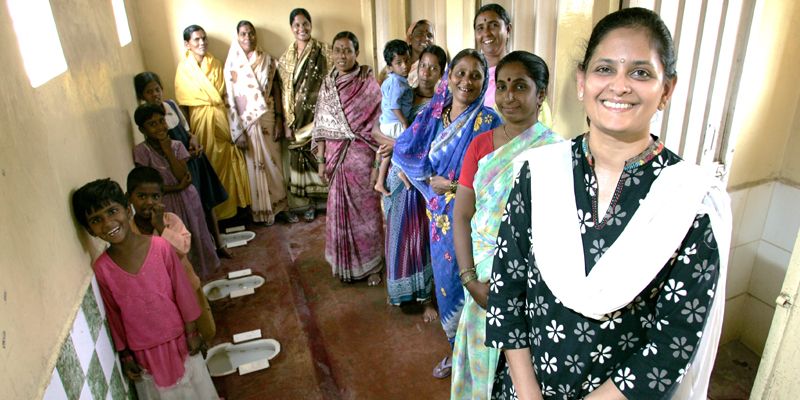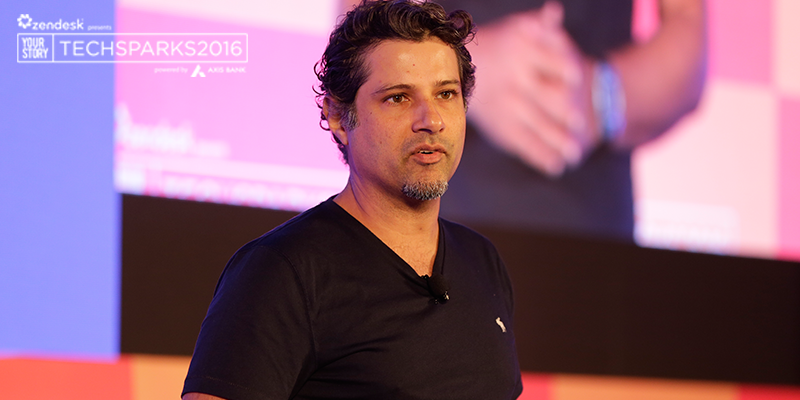Pratima Joshi: “If our slums vanish, our cities will collapse.”

A frail portrait
Between 1990-2012, India increased access to sanitation for 291 million people. Still, 597 million Indians defecate in the open. That roughly accounts for half the Indian population. With the largest percentage of global open defecation, India is also the only country doing the least to remedy this problem. Poorer nations like Bangladesh, Pakistan and Ethiopia (in fact, all of sub-Saharan Africa) have a far better record of improving sanitation access.
Besides lack of access to toilets or functioning toilets, rural Indians who abide by cultural and religious forms of ritual purity prefer defecating in the open. Judging by how bad the problem is, it’s evident the government is not only not providing clean and functioning toilets, but has failed in educating this segment of the population. In fact, the progress has been so sluggish, in 1990, 91% of rural India had no access to sanitation, compared to 67% in 2012, with a disproportionate number of those being from the Hindu community. Overall, India has seen only a 17% increase in sanitation access since 1990. In urban areas, 14% still defecate in the open, 9% have unimproved sanitation and 19% use shared sanitation. Only 58% of those living in urban areas have improved access to sanitation.
In urban India, most of those with sanitation problems tend to belong to the slum community, numbering at 65 million (2013), set to hit 100 million within the next 2-3 years. These people occupy three kinds of slums: recognised, notified and identified. 11 million reside in Maharashtra alone. In slums, sanitation is a problem that comes along with greater problems of inefficient, lacking and poor infrastructure. Development being centred on improving the lives of middle-to-upper class Indians, slums are the most neglected structures in India.
We spoke to Pratima Joshi, the executive director and founder of Shelter Associates, a Maharashtra-based NGO that supports informal settlements for the urban poor, on the importance of slum development.
In 1988, Joshi moved to Pune. Raised in Chennai, she studied architecture there. Shelter Associates was founded in 1993 by Joshi and three other architects with the explicit vision of creating access to better infrastructure and utility service for the urban poor.
Architecture has always been considered an elitist profession. Between temples, forts, malls and corporate buildings, there’s little else we associate architecture with. Joshi says, “All of us in our own way had been inspired to do work in the development sector,” says Joshi. A Building Designs for Developing Countries course in London allowed Joshi to study issues plaguing developing countries due to poor infrastructure. “It was turning point in my life,” Joshi says.
For 21 years now, Shelter has been working with slums in India. However, these 21 years impelled Joshi to realise her work was impossible to achieve without data. “We realised we had absolutely no data about the poor, especially in big cities, where large sections of the population were living in slums. There’s no data to fall back on and a lack of informed decisions because of this.” In the areas Shelter worked, government policies had simply crashed through with little to no improvement of lives. Yet, in spite of old failures, welfare schemes fraught with improvidence were blindly rolled out by bureaucrats. Joshi says, “They were not in keeping with the ground realities. There was no effort to put data in place!”
In the 90s, Shelter decided to take the task of data aggregation upon itself. Joshi had realised that slum development was contingent on holistic data collection. If they were to add a semblance of organisation to the congeries of poor housing units in slums, they needed information on demography, water, sanitation, sewage supply and electricity. In 2000, they decided to use geographic information systems (GIS) technologies to map poverty in Pune. It was a step in a new direction – there was no information available on whether this had been used for mapping poverty in India before. Soon after, the local municipal corporation scaled it further by agreeing to map the entire city using GIS. Till date, Shelter has surveyed more than 300 slums. Joshi says, “Having captured so much primary data on the ground, we started demonstrating how effectively it could be used through [housing] projects we implemented.”

GIS allowed Shelter to pin-point gaps in delivery services. Finally, they could figure out why certain schemes worked, and others didn’t. “You think you’ve provided a service, but maybe it’s not locationally convenient. We started showing the government how this kind of data would help them plan. It’s not about giving services, it’s about how you distribute the services.” In large slums, families were reluctant to walk long distances to get to a toilet – one that serves nearly 50 other families on a daily basis. This way, public toilets can become inefficient, where people feel it’s easier (and cleaner) to simply defecate in the open. Joshi also highlights, “In Pune slums, most people had individual water connections. The city still continued to give the community water stand posts, where water was wasted. If we had had data in place then, these problems could’ve been avoided.” Similar lapses were found in Sangli, another Maharashtrian municipality, where Shelter started a project to maximise land use where land was severely limited.
In 2009, the Rajiv Awas Yojana made mapping the cities’ poor mandatory using GIS and remote sensing technologies. In the meantime, Shelter had begun using Google Earth. “We realised the base map on which we wanted to superimpose the data we’d collected was not good, so we moved to Google Earth.” In the same year, Google Earth Hero made a short documentary on Shelter for using its technology for social betterment, and Joshi received the Ashoka Social Entrepreneurs for Public Fellowship Award. They were also featured in the UN Habitat’s best practice database. TIMESNOW would go on to make a short film for their India Arise series, too. Shelter was officially on the map.
Joshi and her teams have worked for over 15 years on urban sanitation. She says, “We’ve come out with a good methodology to push for one toilet for every house based on good data, awareness workshop modules and a very participatory model. The administration, elected members and all other stakeholders can come together to work out practical solutions.”
India undoubtedly needs an inclusive approach to planning and development. However, poor of the city live in a disparate world. There is a stark and growing difference between the wealthy and poor. This dynamic has built a resentment towards slums for disrupting urban high living. The poor of city are the wretched of the Earth.
“Every citizen needs to sit back and take a really hard look. Slums contribute to the city as much as we do. All the informal sector employment is from there. It’s a very symbiotic relationship, and I don’t think we can do without slums just as much as they cannot do without us. It does not need to be looked as an eyesore or a burden. If our slums vanish, our cities will collapse,” warns Joshi.
Slums are usually occupied by workers in the informal, deprived and disorganised service sector. It’s bad enough they live in places where those who want their services pettifog over giving them their due. “It’s high time,” says Joshi, “we start developing and working towards giving them a better quality of life. Slum settlements have been there for years. In Pune, I can tell you, maybe over 50% of slum dwellers are people who’ve not come yesterday, but those who’ve been here for three generations.” With diseases breeding, poor sanitation and poor healthcare access in such close -sometimes suffocating- quarters, a better life quality for slum dwellers does mean a healthier city.

“They’re not willing to experiment. A lot of these new materials haven’t been tried and tested, yet. They turn around and say, ‘You’re living in brick and concrete building, so don’t experiment on our expense.’” The idea that brick and mortar infrastructure is expensive is also a disingenuous statement. With two decades worth of experience in building small low-cost infrastructure, Joshi says, “It’s not a terribly expensive project. At every step, we’ve minimised any kind of superfluous space. With their participation, we’ve come up with cost-effective designs. However, the cost starts spiralling out of control because of poor governance.” According to Joshi, there is hardly any systematic monitoring and review of projects. This means delivery of services almost always extends beyond the time stipulated for a project to finish. Once this happens, costs start to escalate. There’s always someone in the system who’s not doing his part. Communication between the government and local bodies is almost non-existent, too. NGOs working in the area are not consulted, neither are problems quickly addressed. Duty, punctuality and accountability are not necessarily government traits in most cases. This is all besides the pervasive corruption that swallows chunks of the budget assigned for development. “Our Sangli project was approved in 2009. By 2011 people should have started moving in, but it started only in 2011. Today, not a single family has yet moved and we still have nearly 1,500 houses under construction in their finishing stages. It’s poor governance and the apathy of the system.
“There are very serious challenges the government faces if it’s really keen on pushing every house to have its own toilet by 2019, and for every poor family to have one by 2025.”
In the last 14 months, Shelter has already built over 700 toilets in Pune slums, and over 120 individual toilets in Sangli. Shelter believes infrastructure development cannot happen without community mobilisation. “There’s a whole system that goes in with the hardware. It’s how you intract with the children, women, youth and men. It becomes very important to turn over the data to the people to help them understand what is the status of their own community,” says Joshi.
In Pune, Shelter has mapped over 300 settlements, which is over 70% of them. They mapped the existing water and sewage networks, their sanitation problems and their means of solid waste management. The problem arises when the government refuses to use this wealth of information to plan strategies, whether out of scepticism, political lassitude or bureaucratic torpor. If Shelter’s research is to go by, in the next five years, Pune can accomplish its one-room-one-toilet goal. Nearly 90% of Pune’s slums are well-networked with sewage connections. Even Joshi admits this is highly unusual, but it makes their work easier to achieve. This data needs to be used so the government -for once- properly allocates budget and resources to make planning organised and comprehensive. Joshi says that in a city like Pune, we need some 70-80,000 toilets. It would cost you close to 150 crore, but the mapping itself racks up to about 2 crore. “Is that a huge amount?” she asks. “Even as a percentage of the sanitation programme, the mapping part is insignificant. You can then use that data for every other project. It’s not like you’re doing it again and again.” In fact, investing in data would actually save the government money.
This culture needs to be institutionalised, which is hard when “there is no heat on local governments for the strategies they’re adopting and using the aid they’re using. We need sustained intervention. Every time it cannot be an NGO doing data collection for them.”

In her line of work, Joshi has found that community toilets are the least sustainable. First, they require everyday maintenance, besides routine maintenance. When the projects are handed to private contractors, the state of the toilets has only been a little better. In 2014, the Times of India reported that of 240 public toilets located in “different markets and green belts”, 148 were maintained by private contractors. Yet, their condition was not significantly better than government-maintained toilets in spite of their pay-per-use policy.
“The whole thing starts to crumble,” says Joshi. “If you give every house its toilet, you come out with more sustainable solutions, because every family looks after their toilet. We’ve noticed that they’re more likely to upgrade it over a period of time. The ownership and maintenance responsibility goes back to the people.”
Joshi is of the opinion that when community toilets are used as a substitute for domestic sanitation access, the cost of putting it up, maintaining it and then upgrading it becomes more expensive. The lengthy tango of getting all the right permits itself slows the process by a year. To Joshi, the solution is simple: map, target, provide. “Considering we have the largest population defecating openly, we need to look at sustainable and scalable solutions. We are experimenting with different technologies by giving individual toilets to families, tackle sewage at source to convert it into something that’s not harmful to the environment.” For this reason, Shelter is deeply interested in the DRDO (Defence Research & Development Organisation) bio-toilets. These toilets use biodigester technology to literally ‘eat’ human waste and convert it into usable water and gasses. Though Joshi does add, “Whatever we do put, we need to test it and make sure it’s safe. We can’t pollute or cause other problems that weren’t there earlier. We need to be cautious with new technologies and the impact they may have.”

Over the last four years, Shelter’s been engaged with a small community programme, too.
“It started as a fledgling thing. We wanted to give employment opportunities for women who cannot go out and work. We taught basic skills like sewing. We’ve reached a state where we’re in a process of formulating a cooperative society of these women. They will independently take it forward with a little bit of hand-holding support from us.”
If there was a way to summarise the work Shelter Associates does, Joshi says,
“We do detailed surveys; we involve the communities. At the end of it, you have a pretty clear picture of what is the distribution of wealth within the community, what their aspirations are, their level of education, their occupations and their income. You start getting a fair idea of who they are and what they need. And, we help them with that.”









![[Startup Bharat] Y Combinator-backed BeWell Digital is enabling the digital transformation of radiologists](https://images.yourstory.com/cs/2/40d66ae0f37111eb854989d40ab39087/ImagesFrames31-1648033042143.png)

